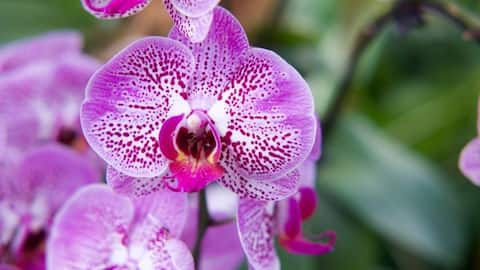How to take care of orchids
What's the story
Orchids, often seen as symbols of luxury and sophistication, are tougher than they look. While they need a bit more care than some other plants, if you give them the right attention, they can grow beautifully and brighten up your home for a long time. Let's explore the details of what it takes to properly care for orchids.
Light
Bright light
Orchids are light-loving plants, but they prefer indirect sunlight rather than direct exposure. Place your orchids near windows where they can receive bright and filtered light. Avoid placing them in intense sunlight to prevent scorching. Getting the right amount of light is essential for indoor orchids if you want them to bloom. Insufficient light is often the main reason why orchids don't flower.
Soil
Growing medium
Many orchids come in regular potting soil in stores which isn't suitable for orchids as it can lead to root rot. Instead, opt for a specialized orchid-growing medium that is lightweight and drains quickly. This can be purchased or made at home using materials like bark, neem, moss, perlite, and peat. It is important to ensure the pH of the medium is slightly acidic.
Watering
Inspect roots
To avoid rot, orchids must dry out between waterings. Check the dryness of the growing medium and the weight of the pot to determine when to water. Alternatively, check the roots: if they're plump and white or green, they're well-hydrated; if they're shriveled and gray, they need water. Be cautious if they're shriveled but spongy and dark in color, as this could indicate rot.
Temperature and humidity
Warm and humid
Orchids thrive in moderate temperatures, typically ranging from 15°C to 27°C during the day and slightly cooler at night. Maintaining a consistent temperature is essential for orchid health. To extend the blooming period of an orchid, maintain a warm and moderately humid environment. You can maintain humidity by placing a tray filled with water and pebbles beneath the orchid pot.
Fertilizer
Balanced fertilizer
Most orchids require weekly fertilization, but it is important to use a more diluted fertilizer mixture compared to what's typically used for other flowering plants. Opt for a high-quality, balanced fertilizer containing nitrogen, phosphorus, and potassium, along with all the essential minor nutrients. Avoid fertilizing orchids during periods of dormancy or when they are not actively growing.
Potting tips
Special pots
When it comes to selecting a pot for repotting orchids, it's crucial to choose one that promotes healthy growth. Clear plastic pots with multiple slots are ideal as they facilitate drainage and enable easy monitoring of root health. These can be placed within more visually appealing ceramic outer pots. Additionally, specialty orchid pots with holes for improved air circulation around the roots are available.
Other tips
Air circulation
Good air circulation is essential for orchids as it helps prevent fungal and bacterial diseases. Avoid placing orchids in stagnant air or overly humid environments. Use fans to promote airflow, especially in enclosed spaces. Regularly remove faded flowers and leaves to stimulate new growth and deter the spread of pests and diseases. Address infestations with suitable treatments such as insecticidal soap or horticultural oil.
